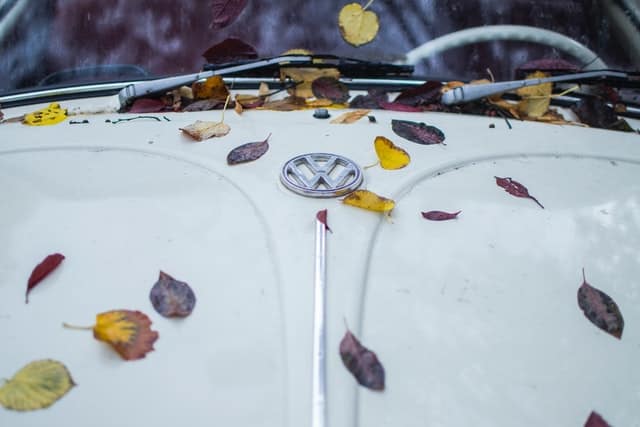Last Updated on March 4, 2025 by Nate Schnell
If you’ve ever parked your car under a tree for an extended period, you may have noticed unsightly stains left behind by fallen leaves. These stains can be tough to remove, and if not dealt with properly, they can damage your car’s paint over time. Leaves release acidic compounds as they decompose, which can etch into the clear coat and create lasting discoloration.
Luckily, with the right approach, you can remove leaf stains from your car and prevent them from coming back. This guide will walk you through the best cleaning methods and protective measures to keep your vehicle looking pristine.
Can Leaves Damage Car Paint?
Many car owners don’t realize how much harm leaves can cause to their vehicle’s paint job. Unlike dirt or dust, which can be washed away easily, leaves contain natural acids that are released as they break down. When they sit on your car for too long, these acids can penetrate the clear coat, leaving stubborn stains behind.
Autumn leaves are particularly acidic, making them even more damaging. If left untreated, leaf stains can become permanent, requiring professional detailing or even paint correction. However, as long as you remove leaves daily and wash your car regularly, you can prevent major damage.
How to Prevent Leaf Stains on Your Car
Keeping leaves off your car is the best way to avoid stains and damage. Here are a few effective strategies:
Remove Leaves by Hand
If leaves have fallen onto your car, don’t brush them off with a cloth or broom. The edges of dry leaves can be abrasive and may cause micro-scratches. Instead, pick them up gently using your hands to avoid unnecessary damage to the paint.
Wash Your Car Regularly
Leaves may leave behind unseen residue, even if they don’t cause immediate stains. Washing your car once a week can help remove any lingering acidic compounds before they have a chance to damage the paint. A high-quality automotive shampoo will effectively lift dirt and organic material without harming the clear coat.
Avoid Parking Under Trees
If possible, try to park your car in a garage or under a carport to prevent leaf buildup. If that’s not an option, look for an open parking space away from large trees, especially during fall when leaves drop in large quantities.
Apply a Protective Wax or Sealant
A coat of wax or ceramic sealant acts as a protective barrier between your car’s paint and contaminants like leaves, sap, and bird droppings. Waxing your car every few months can make it easier to clean and prevent stains from setting in.
Use a Leaf Blower for Quick Cleaning
If leaves frequently land on your car, using a leaf blower can be an effective way to remove them before they cause damage. Electric leaf blowers are quieter and can help clear off dry leaves without requiring physical contact with the paint.
How to Remove Leaf Stains from Car Paint
If you’ve already noticed stains from leaves on your car, don’t worry. With the right cleaning approach, you can get rid of them without damaging your paint.
Step 1: Remove All Leaves
Before cleaning, ensure that all leaves are removed from your car. Pick them up by hand rather than using a brush or cloth to avoid scratching the paint.
Step 2: Wash Your Car with Automotive Shampoo
Once the surface is clear, give your car a thorough wash using a car-safe shampoo. This removes dirt, sap, and any residual organic material from the leaves. Use a microfiber wash mitt and rinse with clean water to prevent scratches.
Step 3: Choose a Stain Remover
For mild leaf stains, a regular car wash might be enough, but stubborn marks require a specialized stain remover. There are several options:
- Meguiar’s Scratch & Swirl Remover is a good choice for tackling leaf stains and other minor blemishes.
- A clay bar treatment can help lift contaminants from the surface, although it requires careful application to avoid causing scratches.
- Dedicated automotive stain removers are also available for more stubborn discoloration.
Step 4: Apply the Stain Remover
Follow the product instructions carefully. Most stain removers work best when applied with a soft microfiber cloth in a circular motion. Avoid aggressive scrubbing, as this can cause damage to the paint. If the stain doesn’t come off immediately, reapply and let it sit for a few minutes before wiping away.
Step 5: Repeat as Needed
Some leaf stains may require multiple applications before they fully disappear. Be patient and continue applying the stain remover until the paint looks clean.
Step 6: Wash the Car Again
After treating the stains, wash your car once more to remove any remaining cleaning residue. This ensures that no chemical residue is left on the paint.
Step 7: Apply a Protective Wax Layer
Once the stains are gone, it’s a good idea to apply a layer of wax to protect the paint from future leaf damage. Wax creates a smooth surface that makes it harder for stains to adhere.
Additional Tips for Leaf Stain Removal
Try a Clay Bar Treatment
While not always necessary, a clay bar can help remove embedded contaminants that aren’t lifted by washing. However, improper use can cause scratches, so be sure to follow the instructions carefully and use a lubricant while applying the clay.
Avoid Using Vinegar or Alcohol
Some DIY cleaning methods suggest using vinegar or rubbing alcohol to remove stains, but these can do more harm than good. Both substances are acidic and can strip away protective coatings, leaving your car vulnerable to further damage. Always use products specifically designed for automotive paint.
If Stains Persist, Seek Professional Help
Most surface stains can be removed at home, but if you’re dealing with deep stains or paint etching, a professional detailer may be necessary. They have specialized tools and polishing compounds that can restore the paint without causing further damage.
Final Thoughts
Leaves may seem harmless, but when left on your car for too long, they can cause serious damage. The acids released during decomposition can stain and degrade your paint, leading to costly repairs if not addressed.
By removing leaves quickly, washing your car regularly, and applying a protective wax coating, you can prevent stains and keep your car looking pristine. If stains do occur, using a high-quality stain remover and following proper cleaning techniques will help restore your paint without causing damage.
Taking care of your car’s paint isn’t just about aesthetics—it’s about protecting your investment. With a little maintenance and the right cleaning methods, you can enjoy a stain-free, well-protected vehicle for years to come.



